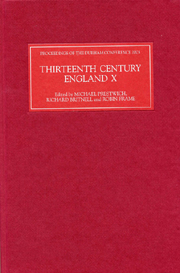Book contents
- Frontmatter
- Contents
- PREFACE
- ABBREVIATIONS
- The Meetings of Kings Henry III and Louis IX
- Counting the Cost: The Financial Implications of the Loss of Normandy
- Networks of Markets and Networks of Patronage in Thirteenth-Century England
- Three Alien Royal Stewards in Thirteenth-Century England: The Careers and Legacy of Mathias Bezill, Imbert Pugeys and Peter de Champvent
- The Eyre de terris datis, 1267–1272
- Joan, Wife of Llywelyn the Great
- Town and Crown: The Kings of England and their City of Dublin
- English Landholding in Ireland
- The Reception of the Matter of Britain in Thirteenth-Century England: A Study of Some Anglo-Norman Manuscripts of Wace's Roman de Brut
- Fearing God, Honouring the King: The Episcopate of Robert de Chaury, Bishop of Carlisle, 1258–1278
- Cloistered Women and Male Authority: Power and Authority in Yorkshire Nunneries in the Later Middle Ages
- Taxation and Settlement in Medieval Devon
- Clipstone Peel: Fortification and Politics from Bannockburn to the Treaty of Leake, 1314–1318
- Royal Patronage and Political Allegiance: The Household Knights of Edward II, 1314–1321
- ‘Edward II’ in Italy: English and Welsh Political Exiles and Fugitives in Continental Europe, 1322–1364
Taxation and Settlement in Medieval Devon
Published online by Cambridge University Press: 12 September 2012
- Frontmatter
- Contents
- PREFACE
- ABBREVIATIONS
- The Meetings of Kings Henry III and Louis IX
- Counting the Cost: The Financial Implications of the Loss of Normandy
- Networks of Markets and Networks of Patronage in Thirteenth-Century England
- Three Alien Royal Stewards in Thirteenth-Century England: The Careers and Legacy of Mathias Bezill, Imbert Pugeys and Peter de Champvent
- The Eyre de terris datis, 1267–1272
- Joan, Wife of Llywelyn the Great
- Town and Crown: The Kings of England and their City of Dublin
- English Landholding in Ireland
- The Reception of the Matter of Britain in Thirteenth-Century England: A Study of Some Anglo-Norman Manuscripts of Wace's Roman de Brut
- Fearing God, Honouring the King: The Episcopate of Robert de Chaury, Bishop of Carlisle, 1258–1278
- Cloistered Women and Male Authority: Power and Authority in Yorkshire Nunneries in the Later Middle Ages
- Taxation and Settlement in Medieval Devon
- Clipstone Peel: Fortification and Politics from Bannockburn to the Treaty of Leake, 1314–1318
- Royal Patronage and Political Allegiance: The Household Knights of Edward II, 1314–1321
- ‘Edward II’ in Italy: English and Welsh Political Exiles and Fugitives in Continental Europe, 1322–1364
Summary
A brilliant paper by William Hoskins, published in 1952 and entitled ‘The Wealth of Medieval Devon’, was the first perhaps to bring medieval lay subsidies to the service of local economic and social history. Beginning with a sidelight from his own personal view of state authority – ‘tax assessments usually make melancholy reading’ – he went on to analyse the returns for Devon from the lay subsidy of 1334, famous for its almost complete coverage of England, and then added some highly suggestive pages on fifteenth-century taxation and economic growth (which will not concern us here). He argued that Devon in the early fourteenth century (and by implication in the thirteenth) was peopled by ‘a rather poor peasantry’ and was ‘one of the most backward counties of England’, largely because ‘the county was colonized late’ and there was ‘still a vast amount to be done before its agricultural resources could be said to be fully exploited’. The county's total wealth, compared to that of, say, Oxfordshire and other Midland counties, appears dismal when measured through the tax returns for 1334.
Since Hoskins wrote his important paper, a major advance in our understanding of the lay subsidy of 1334 has been provided by Robin Glasscock's edition of all of the rolls, with a map showing regional variations in wealth throughout England. All taxed counties are split on this map into many smaller sub-divisions and assessed wealth per square mile is shown for each of these.
- Type
- Chapter
- Information
- Thirteenth Century England XProceedings of the Durham Conference, 2003, pp. 167 - 186Publisher: Boydell & BrewerPrint publication year: 2005



